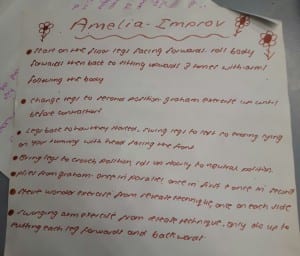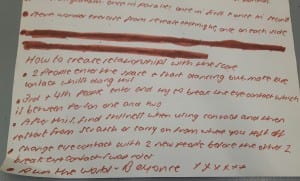– I did my share of experimenting and examining with structures, some I got more involved in. I enjoyed the functions score because you had to figure out ways to move when you had an obstacle in the way. When I was the material I had to move differently to how I wanted, and it made new material come out of my body because I had restrictions. Making relationships within was more open than what I thought, I never thought of using the audience or space as a partner. Experimenting with how to include the audience was difficult at first, however I liked the idea of inviting and refusing them to see what I was doing. Therefore, it made me think how to do the movement, if I wanted something hard to see I did the movement small. The space becoming my partner was interesting, I could use all my body on the floor and give weight to it. Another aspect would be using objects in the space as a partner, for instance the scaffolding could be a tree to climb.
– Throughout, my starting points changed. At the beginning, I thought you went straight into the space and danced. However, I now know that pedestrian like movements can count as dancing, a wave could develop into a handshake or a roll on to the floor. The idea of sticking to one movement and letting it develop seemed wrong, although this assisted my habitual moves out of my body and allowed new material in. Having the intention to do something influenced my starting points. If I had the intention to join a group but they disappeared when I arrived, I would change my intention. This forced me into the space not knowing what to do, but gave the opportunity to explore movements.
– Being aware of the people around me was simple but there were many things I could take note of. In the last few weeks I pushed myself to be different and juxtaposition what was going on. When everyone was flowing through the movements, I ran across the stage to give the collective an alluring aspect. To create a relationship, I replicated or complimented a movement of someone else’s. In addition to relationships, I bounced off people and let them influence my movements as if it is a conversation.
– Learning different scores helped me relax into improvisation. Making relationships was easier, I could manipulate them and change what they were doing, or have the same dynamic but using a different body part. I move with the music when improvising, and going against it was challenging, however it gave me a new element to work with. When restrictions were brought in, it pushed me to think outside of the box and not do the obvious.
– In the future, I will utilise my improvisation with choreographic skills. If I improvised before choreographing I will have movement material already. If I tracked what I did I could use part of that for my choreography. I could utilise improvisation in warming my body or relieve stress. Doing this I would be listening to what my body wants, not to my mind. I could find new movements due to adapting to how my body wants to move.

